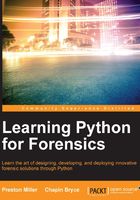
What this book covers
Chapter 1, Now For Something Completely Different, is an introduction to common Python objects, built-in functions, and tropes. We will also cover basic programming concepts.
Chapter 2, Python Fundamentals, is a continuation of the basics learned in the previous chapter and the development of our first forensic script.
Chapter 3, Parsing Text Files, discusses a basic Setup API log parser to identify first use times for USB devices and introduce the iterative development cycle.
Chapter 4, Working with Serialized Data Structures, shows how serialized data structures such as JSON files can be used to store or retrieve data in Python. We will parse JSON-formatted data from the Bitcoin blockchain containing transaction details.
Chapter 5, Databases in Python, shows how databases can be used to store and retrieve data via Python. We will use two different database modules to demonstrate different versions of a script that creates an active file listing with a database backend.
Chapter 6, Extracting Artifacts from Binary Files, is an introduction to the struct module, which will become every examiner's friend. We use the struct module to parse binary data into Python objects from forensically relevant sources. We will parse the UserAssist key in the registry for user application execution artifacts.
Chapter 7, Fuzzy Hashing, explains how to implement a block-level rolling hash in Python to identify changes within two similar files based on content.
Chapter 8, The Media Age, helps us understand embedded metadata and parse them from forensic sources. In this chapter, we introduce and design an embedded metadata framework in Python.
Chapter 9, Uncovering Time, provides the first look at the development of the graphical user interface with Python to decode commonly encountered timestamps. This is our introduction to GUI and Python class development.
Chapter 10, Did Someone Say Keylogger?, shows how a malicious script could be developed with Python. This chapter, unlike others, focuses on Windows-specific modules and introduces more advanced features of the Python language.
Chapter 11, Parsing Outlook PST Containers, demonstrates how to read and interpret the Outlook PST container and index contents of this artifact.
Chapter 12, Recovering Transient Database Records, introduces SQLite Write-Ahead Logs and how to extract data, including deleted data, from these files.
Chapter 13, Coming Full Circle, is an aggregation of scripts written in previous chapters into a forensic framework. We explore the methods for designing these larger projects.
Appendix A, Installing Python, is a tutorial on how to install Python for various Operating Systems.
Appendix B, Python Technical Details, is a brief discussion on the inner workings of Python and how it executes code.
Appendix C, Troubleshooting Exceptions, contains the descriptions and examples of common exceptions encountered during development.